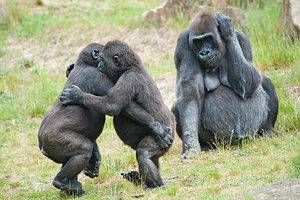Gorillas are the world’s largest living primate species weighing in at a maximum of 860 pounds! You can learn more about the world’s largest gorilla here. These are definitely very big creatures, but does their strength match their size? At first glance, a gorilla’s muscular build would suggest yes, that they are very strong, especially when it comes to the silverback gorilla strength. But how strong is a gorilla? This article will investigate how gorillas maintain their incredible size and strength and will ask: how strong are gorillas?
How a Gorilla’s Body Adds to their Strength
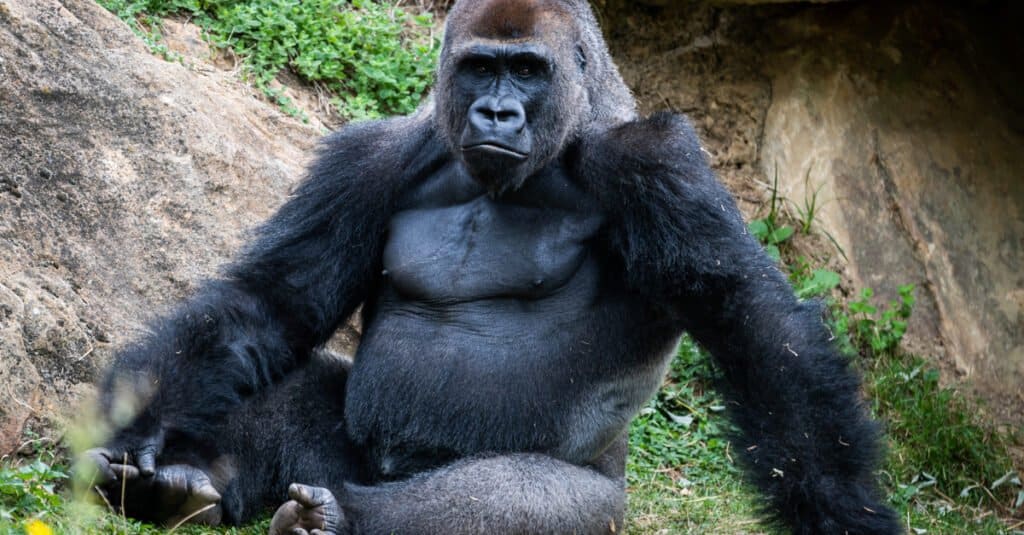
Gorillas are the largest primates in the world!
©AB Photographie/Shutterstock.com
How strong are gorillas? Much of a gorilla’s strength can be attributed to its large body size. Wild male gorillas weigh between 300 and 500 pounds on average, and females weigh between 150 and 250 pounds. The large difference in size between males and females is an example of sexual dimorphism. Sexual dimorphism is a natural phenomenon where males and females of the same species have very distinct characteristics, such as size or coloration. This is very common in the animal kingdom, especially amongst primates.
When male gorillas reach a certain level of maturity, generally 12 years of age, they start moving into a new category called the silverbacks. Obviously, they are named this because of the silver coloration on their back. Because of their age, the silverback gorilla’s strength is generally stronger than the younger and much older apes in an area.
Of the great apes, orangutans and gorillas are the largest and are both exceptionally strong. These two apes, however, move around very differently, which has had a substantial influence on their body structures over evolutionary time. Since orangutans move around by hanging and swinging on branches, also known as brachiation, they have developed specialized shoulder joints and unique muscle distribution.
Gorillas have adaptations for quadrupedal locomotion, which is walking on four limbs. As a result, gorillas have joints capable of stable terrestrial movement and very muscular hindlimbs for weight-bearing and propulsion. Both orangutans and gorillas in these examples demonstrate how everyday functionality affects structure over time. The way they walk, therefore, has greatly influenced their musculature and how strong gorillas are. Click for more on functional adaptations in gorillas.
Are Gorillas Stronger than Orangutans?
How strong is a gorilla compared to an orangutan? The average weight of a gorilla is almost twice that of an orangutan–400 lbs vs. 200 lbs. Gorillas are also much faster than orangutans in terms of ground speed, reaching running speeds of up to 25mph, while the latter only runs 2-3 mph. The gorilla’s bite force is also highly powerful, clocking at 1,300PSI of force. The orangutan’s bite is actually less powerful than a human’s, so it does not come close to that of a gorilla. In a physical fight, an orangutan may bite or hit an opponent with an object. But a gorilla is capable of lifting over 1000 lbs, punching, pulling, and throwing its enemies. So it’s safe to say that a gorilla is a much stronger creature than an orangutan.
How Much Stronger Are Gorillas Than a Human?
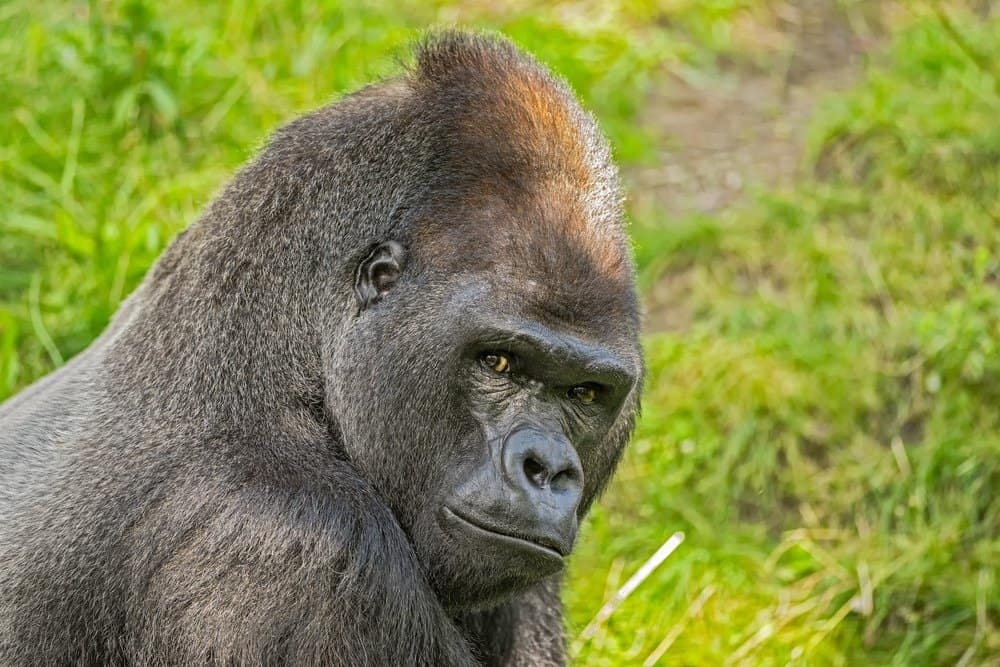
When it comes to strength, gorillas reign supreme over humans.
©Nick Fox/Shutterstock.com
Gorillas have immense muscle strength that is significantly stronger than a human. While all apes exceed human strength, the silverback gorilla is the clear winner, with a powerful brawn that is 20 times greater than a human, or 20 humans combined. They are able to lift, on average, almost 1800 pounds, which when compared to the almost 800 pounds a well-trained human can lift, is an incredible feat.
However, even the average gorilla is able to lift more than an adult human, with the ability to lift almost 1,000 pounds. Even their punch strength is incredible, with the ability to deliver between 1300 to 2700 pounds of force. Compare that to a human who is capable of delivering an estimated 150 pounds of force.
What do Gorillas Eat to Get So Strong?
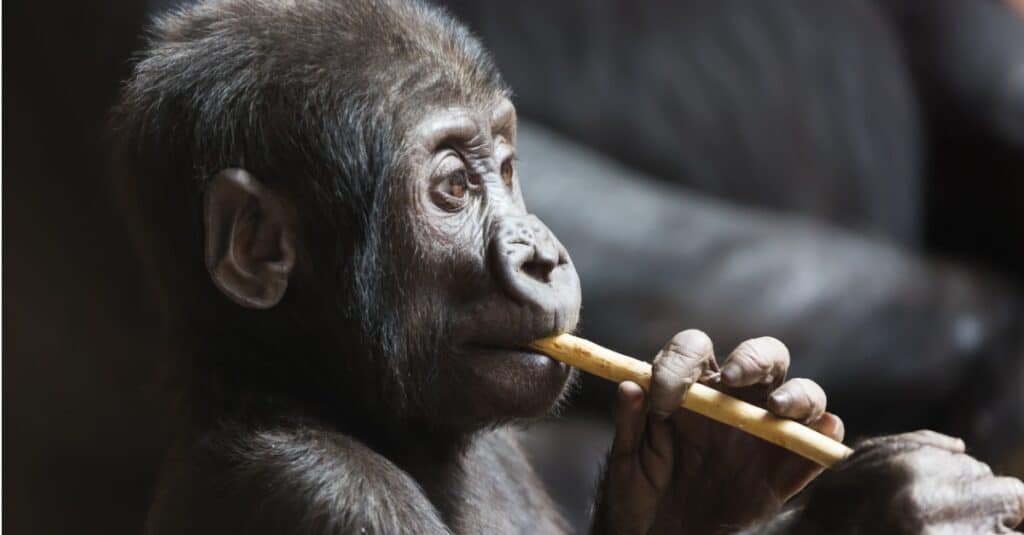
A baby gorilla chewing on a stick.
©iStock.com/nantonov
Gorillas must eat a lot of meat to fuel such size and strength, right? Surprisingly, gorillas are primarily herbivores. There is some variation in diet amongst the different gorilla subspecies, but their diets typically include foliage, fruit, and other plant material. The leaves and foliage that gorillas rely on are low in nutrients, so they must eat a large volume to meet their needs. Eastern and western lowland gorillas also occasionally eat ants and termites.
The Most Weight Ever Lifted by a Gorilla
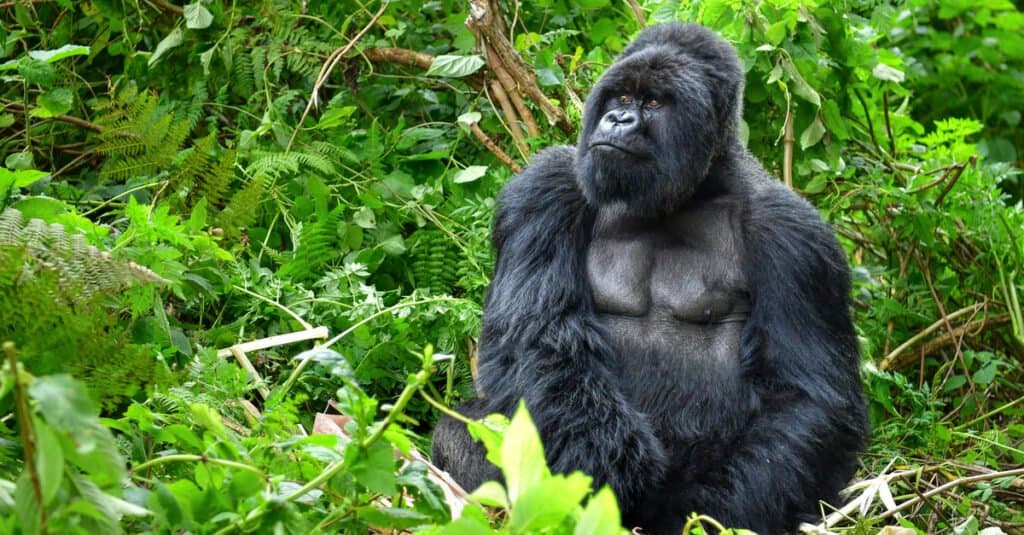
A gorilla relies on its strong jaw muscles to consume food such as nuts and tree bark.
©Onyx9/Shutterstock.com
So, how strong is a gorilla? According to the Guinness World Records, the most weight a gorilla is on record lifting is 1,800 pounds! Some hypotheses have suggested that gorillas can lift up to 10 times their body weight. To put that into perspective, the average American male can lift 0.87 times his body weight.
What are Some Other Strong Animals?

A female elephant, like the one seen here, can weigh several tons.
©iStock.com/saha_avijan
Many other animals are exceptionally strong relative to their size. The leafcutter ant, for example, can carry loads up to 50 times its body weight! These ants use their strength to cut leaves that they bring back to their colonies. Oxen have historically been very important to the agricultural industry because individually, they have a towing capacity of 1,680 pounds. Elephants are the strongest of all in the animal kingdom and can lift up to 19,800 pounds!
How are Gorillas Doing Today?

An infant gorilla clings to its mother.
©Asaf Weizman/Shutterstock.com
All subspecies of gorillas are in grave danger today. Mountain gorillas are listed as endangered on the IUCN Red List. Western and eastern lowland gorillas and Cross River gorillas are categorized as critically endangered. “Critically endangered” is the most severe status before extinction in the wild and total extinction. The western gorilla is more populous than the eastern gorilla. However, the number of individuals in the wild is very low.
Gorillas face the major threat of poaching- being intentionally hunted and killed or unintentionally killed by traps set for other animals. Habitat destruction, disease, and war also have heavy effects on gorilla populations. In times of civil unrest, refugees have turned to bushmeat for sustenance, and gorillas, as well as other apes, have suffered as a result. Because gorillas are so closely related to humans, they can suffer from different diseases transmitted by humans. In 2004, Ebola ravaged gorillas in the Republic of Congo, effectively eliminating the population there. Recent estimates suggest as many as 5,000 gorillas have died from Ebola.
Different conservation efforts are in place that have had many positive impacts. There used to be fewer than 880 mountain gorillas alive, but in 2018 they were reclassified from critically endangered to endangered as their population grew past 1,000 individuals. Breeding programs in various zoos attempt to repopulate both species directly. Organizations and laws also exist to protect gorillas. The Great Apes Survival Partnership (GRASP) aims to conserve all nonhuman great apes, including gorillas. Also, the Gorilla Agreement is legislation that targets gorilla conservation specifically.
10 Fun Gorilla Facts
- Gorillas are the largest living primates, with males weighing up to 400 pounds and standing 6 feet tall when upright.
- They live in groups of 2-30 individuals called troops, led by a dominant male known as a silverback due to the streak of grey hair on his back and shoulders.
- Gorillas have opposable thumbs like humans which allow them greater dexterity than other primates in manipulating objects such as branches or fruits for food sources.
- The diet of gorillas consists mainly of vegetation, including leaves, shoots, roots, and fruit, but they will also eat small insects for additional protein supplementation if necessary.
- Despite their large size, gorillas can move quickly through trees using their long arms for balance while swinging from branch to branch at speeds up to 25 miles per hour!
- Their vocalizations include barks, grunts, and hoots that are used to communicate within the troop about threats or potential danger from predators in the area, such as leopards or eagles looking for easy meals!
- Gorilla infants remain with their mothers until around four years old before venturing out into their own social groupings with other young adults of similar age ranges forming bachelor groups away from adult males who may try to dominate them otherwise!
- Gorillas are considered highly intelligent animals based upon studies conducted where they have demonstrated problem-solving abilities along with emotional intelligence shown through expressions of joy when reunited with family members.
- Gorillas use tools for different tasks, such as using sticks to measure water depth or using rocks to crack open nuts.
- Studies suggest that gorillas even possess a sense of self-awareness which is evident in their ability to recognize themselves in the mirror – something only a few species on Earth can do!
The photo featured at the top of this post is © iStock.com/SooniosPro
Thank you for reading! Have some feedback for us? Contact the AZ Animals editorial team.





